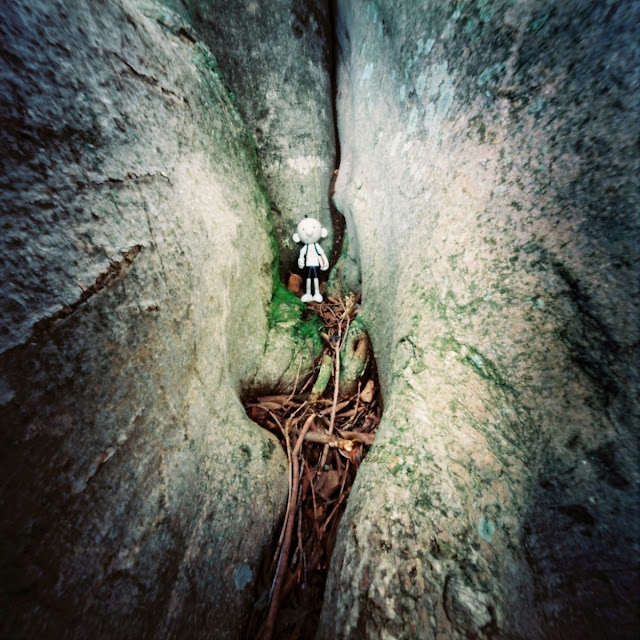 |
| Self-portrait, from the series Homebound Pinholes |
 |
| Ross's winning image from Holga Week 2014 entitled "Paradise Seat" |
I was born in Kea‘au on the island of Hawai‘i, and spent my early years wandering about Pearl City, O‘ahu. I've photographed since I was a youngster, documenting my family life and travels with a Kodak Instamatic.
I've enrolled in a number of photography workshops and classes that have broadened my view of photography. Through my education at the University of Hawai‘i at Mānoa Art Department, I've discovered that photography can be an evocative and powerful means of expressing ideas. My artworks often reflect themes pertaining to the human condition, identity, history, and geography.
I recently retired after working nearly 30 years for the University of Hawai‘i Library, and the last 24 years as the Map and Aerial Photograph Technician. I am looking forward to continuing my exploration of toy cameras and pinhole photography in my new found spare time.
 |
| Engulfed, from the series Pinhole Trees |
How did you get introduced to your first Holga and how long have you been shooting?
I was introduced to the fun and sometimes unpredictable world of Holgas and toy cameras about 10 years ago while taking photography classes at the University of Hawai‘i. Several advanced photo students were doing compelling work with their Holgas and Dianas. It was during this time that I also learned about pinhole photography. I purchased a 3rd party over-the-counter PinHolga shortly after, although it arrived with a fatal shutter defect.
 |
| Self-modified PinHolga and PinHolgaroid |
What is it about the Holga that draws you to it? Why do you shoot with it?
The defective PinHolga turned out to be a blessing in disguise. It gave me the opportunity to take a screwdriver and fix it - something I wouldn’t have attempted with a more complex or expensive camera. The Holga’s simple design and plastic parts enticed me to “hack and glue” and create an even better and more reliable PinHolga. I’ve been making pinhole cameras ever since! I continue to use and modify PinHolgas because their ease in customizing encourages and helps satisfy my need to build new things. Also, the Pin-Holga’s potential to record images with a unique feel and look continues to enchant me.
 |
| Destiny, from the series Pinhole Trees |
Please tell me a bit about your series in which you use a Holga
My pinhole photography is theme-based. I create images that frequently fall into one of five or six different series. I customarily use a variety of pinhole cameras, and there is no one series that is PinHolga-specific.
 |
| Japanese Glass Net Floater, from the series Pinholes at High-tide |
 |
| Toy Car and Lighter, from the series Pinholes at High-tide |
What are some of your biggest challenges shooting with a Holga and do you have any tips for over coming them?
Aside from the usual mechanical shortcomings that can be fixed if so desired (loose sponges, light-leaks, etc.), the greatest challenge for me is creating artwork that is meaningful and unique. I still struggle with this, but I hope that persistence and hard work will eventually lead us on the path towards fulfilling our artistic goals.
 |
| Treehouse, from the series Pinhole Chairs |
 |
| Mānoa Stream, from the series Pinhole Chairs |
What is your biggest piece of advice for someone just starting out with a Holga?
My advice for anyone with a new piece of equipment, and not just Holgas: “Use it a lot, and use it often”. With familiarity, perseverance, and a bit of luck, comes successful images. Too frequently we are enticed by the next piece of new gear without even giving what we already own a good trial. I speak from experience, being a former “gear-head”!
 |
| Library, from the series Homebound Pinholes |
What do you consider "must-haves" when shooting with your Holga and why?
There are three things that I consider essential when I use my PinHolgas. First, a sturdy and easy-to-use tripod is crucial for long pinhole exposures. Secondly, good metering technique is required for proper exposures. If possible, I don’t leave exposures up to chance. A reliable light-meter takes up very little space in my camera bag. Thirdly, and most important of all is keeping an open mind. Only with an open mind can one be receptive to new possibilities!
 |
| Stifled, from the series Homebound Pinholes |
What other cameras do you have in your arsenal?
I use regularly a handful of home-made pinhole cameras. Each camera was created for a specific purpose, different types of film, and/or focal length. I also own a few other non-pinhole cameras, but these are less frequently used in my artwork now.
Favourite photo film(s)?
I particularly like Kodak Ektar 100 (120 roll film) for outdoors/sunlight, and I am also enjoying Impossible Project’s instant integral films for indoor still-lifes.
 |
| Aiea Cemetery, O‘ahu, from the series Pinholes at Sacred Places |
What inspires you?
One source of inspiration is my own life and personal experiences. I may not live a very exciting life, or see the most incredible scenes, but if I have a statement to make with my artwork, it usually comes from deep within. I think it is vitally important to photograph a subject that is close to heart. I also find the work of other established photographers and artists to be influential. I enjoy looking through photography books, visiting art museums and exhibitions, and also watching artfully done films. I strive to keep an open eye and open mind, and to also carefully examine the works of many different artists.
 |
| Circle Dance, Byodo-in Temple, O‘ahu, from the series Pinholes at Sacred Places |
You can find out more about Ross and his work at the following links:
Flickr: https://www.flickr.com/people/36exposures/
YouTube: https://www.youtube.com/user/artyfotos
Email: rtogashi@gmail.com








No comments:
Post a Comment